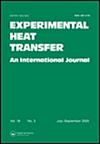V形肋与弧形肋相结合的混合肋型太阳能空气加热器的热液性能
IF 2.9
3区 工程技术
Q2 ENGINEERING, MECHANICAL
引用次数: 0
摘要
摘要太阳能是一种取之不尽用之不竭的生态友好型可再生能源,可用于加热/制冷、发电、干燥和热处理工业等领域。太阳能空气加热器(SAHs)是利用太阳能进行加热和干燥等热目的的最佳选择之一。然而,SAH的性能还不足以投入实际应用。SAH的低性能主要是由于其吸收板光滑,对流换热能力较低。在这方面,本文尝试利用混合肋来提高SAH的传热能力。在2000 ~ 16000雷诺数范围内,设计了包含V形肋和圆弧形肋的混合肋粗糙度模式,并在SAH管道中进行了实验测试。在30º~ 75º、30º~ 75º、0.2 ~ 0.10、8 ~ 10和0.023 ~ 0.043范围内,分别得到了弧角(α)、攻角(β)、相对V肋位置(d/w)、相对肋间距(p/e)和相对肋高(e/ d)等不同的粗糙度模式。因此,Nusselt number (Nu)和friction factor (f)得到了显著的提高。在α = 45º,β = 60º,d/w = 0.65, p/e = 10, e/ d = 0.043时,Nu的最大增强为3.08。在α = 30º,β = 60º,d/w = 1.0, p/e = 10, e/ d = 0.043时,热液性能(TP)参数最大值为2.18。关键词:热工性能混合肋型太阳能空气加热器自我编号致谢本工作在印美项目(GAP-806)下进行。披露声明作者未报告潜在的利益冲突。本文章由计算机程序翻译,如有差异,请以英文原文为准。
Thermohydraulic performance of hybrid ribs pattern combining V and arc shape ribs in solar air heater
ABSTRACTSolar energy is a limitless and ecological-friendly renewable energy source, which can be utilized for varieties of application ranging from heating/cooling, power generation, drying, and in heat-processing industries. Solar air heaters (SAHs) are among the best options for harnessing solar energy for thermal purposes like heating and drying. However, the performance of SAH is not sufficient to take into practical applications. Low performance of SAH is due to its low convective heat transfer capability because of smooth absorber plate. In this regard, an attempt has been made to enhance the heat transfer capability of SAH exploiting hybrid ribs in this paper. Hybrid rib roughness pattern incorporating to V shape ribs and arc shape ribs has been designed and tested experimentally in the SAH duct under the following range of Reynolds number (Re) from 2000 to 16,000. The various roughness patterns, i.e., arc angle (α), angle of attack (β), relative V ribs position (d/w), relative rib pitch (p/e), and relative rib height (e/D), have been exploited in the range of 30º-75º, 30º-75º, 0.2–0.10, 8–10, and 0.023–0.043, respectively. As a result, Nusselt number (Nu) and friction factor (f) have been enhanced significantly. Maximum enhancement in Nu has been found as 3.08 at α = 45º, β = 60º, d/w = 0.65, p/e = 10, and e/D = 0.043. Thermohydraulic performance (TP) parameters have also been evaluated for all set of parameters of hybrid ribs pattern and it found to be maximum 2.18 at α = 30º, β = 60º, d/w = 1.0, p/e = 10, and e/D = 0.043.KEYWORDS: Thermohydraulic performancehybrid ribs patternsolar air heaternusselt number AcknowledgmentsThis work is carried out under Indo-US Project (GAP-806).Disclosure statementNo potential conflict of interest was reported by the author(s).
求助全文
通过发布文献求助,成功后即可免费获取论文全文。
去求助
来源期刊

Experimental Heat Transfer
工程技术-工程:机械
CiteScore
6.30
自引率
37.10%
发文量
61
审稿时长
>12 weeks
期刊介绍:
Experimental Heat Transfer provides a forum for experimentally based high quality research articles and communications in the general area of heat-mass transfer and the related energy fields.
In addition to the established multifaceted areas of heat transfer and the associated thermal energy conversion, transport, and storage, the journal also communicates contributions from new and emerging areas of research such as micro- and nanoscale science and technology, life sciences and biomedical engineering, manufacturing processes, materials science, and engineering. Heat transfer plays an important role in all of these areas, particularly in the form of innovative experiments and systems for direct measurements and analysis, as well as to verify or complement theoretical models.
All submitted manuscripts are subject to initial appraisal by the Editor, and, if found suitable for further consideration, to peer review by independent, anonymous expert referees. All peer reviews are single blind and submission is online via ScholarOne Manuscripts. Original, normal size articles, as well as technical notes are considered. Review articles require previous communication and approval by the Editor before submission for further consideration.
 求助内容:
求助内容: 应助结果提醒方式:
应助结果提醒方式:


